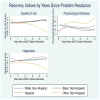Beyond Abstinence: Changes in Indices of Quality of Life with Time in Recovery in a Nationally Representative Sample of U.S. Adults
- PMID: 29473966
- PMCID: PMC5880708
- DOI: 10.1111/acer.13604
Beyond Abstinence: Changes in Indices of Quality of Life with Time in Recovery in a Nationally Representative Sample of U.S. Adults
Abstract
Background: Alcohol and other drug (AOD) treatment and recovery research typically have focused narrowly on changes in alcohol/drug use (e.g., "percent days abstinent") with little attention on changes in functioning or well-being. Furthermore, little is known about whether and when such changes may occur, and for whom, as people progress in recovery. Greater knowledge would improve understanding of recovery milestones and points of vulnerability and growth.
Methods: National, probability-based, cross-sectional sample of U.S. adults who screened positive to the question, "Did you used to have a problem with alcohol or drugs but no longer do?" (Response = 63.4% from 39,809; final weighted sample n = 2,002). Linear, spline, and quadratic regressions tested relationships between time in recovery and 5 measures of well-being: quality of life, happiness, self-esteem, recovery capital, and psychological distress, over 2 temporal horizons: the first 40 years and the first 5 years, after resolving an AOD problem and tested moderators (sex, race, primary substance) of effects. Locally Weighted Scatterplot Smoothing regression was used to explore turning points.
Results: In general, in the 40-year horizon there were initially steep increases in indices of well-being (and steep drops in distress), during the first 6 years, followed by shallower increases. In the 5-year horizon, significant drops in self-esteem and happiness were observed initially during the first year followed by increases. Moderator analyses examining primary substance found that compared to alcohol and cannabis, those with opioid or other drugs (e.g., stimulants) had substantially lower recovery capital in the early years; mixed race/native Americans tended to exhibit poorer well-being compared to White people; and women consistently reported lower indices of well-being over time than men.
Conclusions: Recovery from AOD problems is associated with dynamic monotonic improvements in indices of well-being with the exception of the first year where self-esteem and happiness initially decrease, before improving. In early recovery, women, certain racial/ethnic groups, and those suffering from opioid and stimulant-related problems appear to face ongoing challenges that suggest a need for greater assistance.
Keywords: Alcohol Use Disorder; Epidemiology; National; Quality of Life; Recovery; Remission.
Copyright © 2018 by the Research Society on Alcoholism.
Figures





References
-
- Battaglia MP, Hoaglin DC, Frankel MR. Practical considerations in raking survey data. Survey Practice. 2009;2(5):1–10.
-
- Betty Ford Institute Consensus Panel. What is recovery? A working definition from the Betty Ford Institute. J Subst Abuse Treat. 2007;33(3):221–228. - PubMed
-
- Bureau of Justice Statistics. Drug Use and Dependence, State and Federal Prisoners, 2004. Washington, DC: Office of Justice Programs, Bureau of Justice Statistics. Department of Justice publication NCJ 213530; 2006. [Accessed November 30, 2017]. Available at: https://www.bjs.Gov/Content/Pub/Pdf/Dudsfp04.pdf. Revised January 19, 2007.
-
- Center for Behavioral Health Statistics and Quality. 2015 National Survey on Drug Use and Health (NSDUH): Methodological Summary and Definitions. Rockville, MD: Substance Abuse and Mental Health Services Administration; 2016. - PubMed
Publication types
MeSH terms
Grants and funding
LinkOut - more resources
Full Text Sources
Other Literature Sources
Medical

